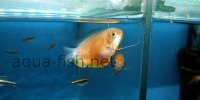The Ultimate Dwarf Gourami Care and Breeding Guide
This guide covers the basics of raising, feeding, and breeding Dwarf Gouramis. Just scroll down, and if you don’t find the answer to your question, feel free to use the form at the bottom to ask! You may also want to check out this page: Dwarf Gourami - Colisa lalia Profile. The Dwarf Gourami is a small member of the Gourami family. Males are slightly larger than females, reaching up to 6 cm (2.36 inches) in length. In the wild, males showcase bright and vibrant colors, while females have more subdued shades. These fish come in several color varieties, including Blue/Powder Blue, Neon, Rainbow, and Red/Blushing. Dwarf Gouramis are Labyrinth Fish, which means they breathe air directly, so they need access to the water's surface. It's best to keep them in a tank of at least 15 US gallons (about 57 liters, 12.5 Imperial gallons). The water conditions should be stable, with a pH between 6.5 and 8.0, a temperature of 23.0 to 28.0 °C (73.4 - 82.4 °F), and water hardness (dGH) of 4.0 - 18.0 °N. Maintaining these conditions will help keep your fish healthy, stress-free, and behaving naturally. Due to their peaceful and shy nature, Dwarf Gouramis are well-suited for both smaller and community aquariums. They are generally peaceful, and it's rare for males to fight over territory. This typically only happens in smaller tanks, where there aren't enough plants, or if there is just one female among four or more males. To prevent this, provide plenty of plants, driftwood, tall decorations, caves, and rocks in your aquarium. It's also important not to house them with large or aggressive fish. Dwarf Gouramis thrive in tanks with lots of vegetation, including floating plants that cover part of the water surface. While they enjoy each other's company in groups of at least three males and twice as many females, some males may be overly nervous and spend most of their time hiding. When kept as a pair, they will often swim together. The Dwarf Gourami originates from India, particularly in areas like West Bengal, Assam, and Bangladesh. In these regions, it thrives in densely vegetated aquatic habitats and is often seen swimming alongside other species within the Colisa genus. In the wild, Gouramis feed on small insects and larvae that float on the water's surface, as well as graze on algae growing on aquatic plants. In an aquarium, they readily accept flake food, freeze-dried options like bloodworms (mosquito larvae), frozen foods, and vegetable tablets. To keep them healthy, it's a good idea to occasionally offer live foods such as worms, which are also great for conditioning breeding pairs. It's crucial not to overfeed Dwarf Gouramis. The general guideline is to provide an amount of food that can be eaten within 5 minutes, once a day. Juveniles may need feeding two or three times daily, while fry might require even more frequent feedings, up to 5-6 times a day. If you're keeping just two fish, feeding once daily with an amount that can be consumed in one or two minutes is sufficient to reduce competition for food. However, in a tank with more fish, you may need to extend the feeding time to ensure everyone gets enough to eat. Male Dwarf Gouramis create floating bubble nests, so it's important to have floating plants in the tank. Keep the water temperature around 82°F (approximately 28°C) once the nest is formed. After spawning, it's a good idea to move the female to another tank if the main tank isn't large enough. Therefore, it's best to keep Dwarf Gouramis in a spacious tank with plenty of hiding spots. While the male initially takes care of the eggs and fry, his attention usually diminishes after the fry reach 2-3 days old. Once the fry begin swimming on their own, start feeding them infusoria, and gradually introduce brine shrimp and finely ground flakes. As they grow, you can include freeze-dried tablets in their diet. A common question among fish keepers is "How often do dwarf gouramis breed?". Typically, they can breed once a month or every two months. However, it's not unusual for them to attempt spawning as frequently as possible over a span of, say, three months, followed by a break. Afterward, they might resume their breeding activities. Their breeding frequency depends on food availability, though consistently feeding them earthworms may reduce their response to this trigger. If this happens, the female may become exhausted, leading to less frequent breeding. Sexing Dwarf Gouramis is crucial for successful breeding since two males won't reproduce. Sexing was mentioned earlier at the top of this page, but let's review it again. Like other Gouramis, males are longer and slimmer than females. Female colors are not as bright as those of males. Although Dwarf Gouramis are generally peaceful, males can be more territorial. Therefore, it's relatively easy to keep about 6-7 individuals in an 80-liter aquarium. Once hatched, Dwarf Gouramis can live up to 4 years with proper care. On average, aquarists report a lifespan of 2-3 years. Many thanks to Jose J. for kindly allowing us to use his picture.


Quick links - Answers
Brief Description
Aquarium Setup
Origin
Feeding Dwarf Gouramis
Breeding Dwarf Gouramis



